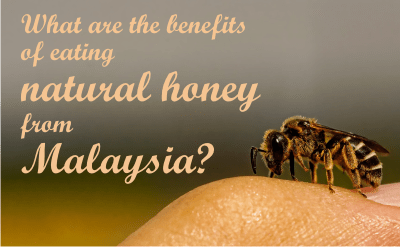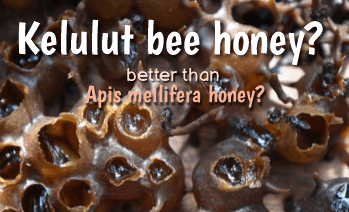Trigona bee honey health benefits have been a little documented based on traditional claims. This honey is also known as kelulut honey (especially in Malaysia), as stingless honey or as pot honey.
Health benefits of Trigona bee honey (kelulut bee honey)
Traditional claims of the health benefits of Trigona honey, summarized by Barakhbah S. A. et al. in 2007, include:
· anti-ageing,
· enhanced libido,
· enhanced immune system,
· fighting bacteria,
· treating bronchial catarrh,
· treating sore throat, coughs and colds,
· smoothing pain,
· restoration after an illness,
· antiseptic,
· cures burns, carbuncle, boils and diabetic wounds.
There is a number of reports that have documented the beneficial effects of stingless bee honey in different contexts and confirmed the antimicrobial, antioxidant, anti-inflammatory activities of stingless honey:
Antimicrobial properties of kelulut bee honey
• Trigona carbonaria, was one of the 11 types of stingless honeys studied by Boorne et al. in 2010, that showed antimicrobial activity against several types of microorganisms collected from thirteen clinical samples in addition to standard reference strains.
• The study from 2013 conducted by Zainol MI investigated antibacterial activity of five varieties of Malaysian honey (three monofloral; acacia, gelam and pineapple, and two polyfloral; kelulut and tualang). The results showed that Malaysian honeys: gelam, kelulut and tualang, have high antibacterial potency derived from total and non-peroxide activities, implying that both peroxide and other constituents are mutually important as contributing factors to the antibacterial property of honey.
• Chanchao et al. showed in 2009 that Trigona laeviceps, a stingless bee found in Thailand, produces a honey with antimicrobial activity against several types of bacteria (E. coli and S. aureus), the fungal strain (Aspergillus niger) and 2 types of yeasts (Auriobasidium pullulans and C. albicans).
• Tetragonisca angustula (T. angustula), a stingless bee commonly found in Brazil and Mexico, produces honey that has been well documented and was found to possess good antimicrobial activity against the bacterium S. aureus (according to Miorin et al., 2003).
Another study conducted by DeMera and Angert in 2004, revealed that this honey has significant antimicrobial activity against several different bacterial strains, including
– Bacillus cereus (Gram positive bacteria) and Pseudomonas aeruginosa (Gram negative bacteria),
– yeasts such as Candida albicans and Saccharomyces cerevisiae.
Sgariglia et al. also confirmed in 2010 the antibacterial activity of T. angustula honey on Gram positive bacteria such as Staphylococcus aureus and Enterococcus faecali, as well as coagulase-negative methicillin-sensitive and Gram negative bacteria such as P. aeruginosa and E. coli.
Antioxidant activities
Kek S. P et al showed in 2014 the antioxidant properties of Trigona bees in their study “Total phenolic contents and colour intensity of Malaysian honeys from the Apis spp. and Trigona spp. bees”.
Vattuone et al. showed in 2007 that 2 types of stingless bee honeys: Trigona angustula and Plebeia wittmanni have good antioxidant activity.
Another study conducted by Dda Silva et al., 2013 in the Northeastern regions of Brazil revealed that stingless bee honey from Melipona (Michmelia) seminigra merrillae possesses antioxidant potential. Furthermore, T. carbonaria, Melipona fasciculate, Melipona subnitida and Melipona aff. Fuscopilosahoneys showed significant antioxidant activity in vitro.
Among all stingless bee honey samples, T. carbonaria had the best antioxidant activities, indicating that the antioxidant potential of honey varies based on type.
Due to its strong antioxidant activities, stingless honey could be one of the potential chemopreventive agents from natural resources.
• The study from 2016, Chemopreventive Properties and Toxicity of Kelulut Honey inSprague Dawley Rats Induced with Azoxymethane , conducted by Latifah Saiful Yazan from the Department of Biomedical Science, Universiti Putra Malaysia, investigated the chemopreventive properties of kelulut honey towards Sprague Dawleyrats induced with AOM (colorectal cancer).
The rats received 1183 mg/kg bodyweight of kelulut honey (trigona honey) – the dose was trying to mimic the way kelulut honey is being traditionally consumed by humans, which was a daily intake of 189.33 mg/kg, taken twice (in the morning and in the evening).
The results showed that kelulut honey has chemopreventive properties in rats induced with colon cancer by reducing the development of ACF (aberrant crypt foci), AC (aberrant crypts), and crypt multiplicity. Kelulut honey was also found to be non toxic towards the animals.
Trigona bee honey has anti-aging activities
Afrouzan H et al showed in 2007 that stingless propolis has anti-aging activities in the study “Comparison of gymnosperms and angiosperms plants on quality and quantity of propolis.”
Kelulut honey has anti-inflammatory properties
The propolis collected by stingless bees in Indonesia was proved to have anti-inflammatory properties. The study “Histological analysis of rat dental pulp tissue capped with propolis.”, by Sabir A et al from Indonesia, showed that direct pulp capping with propolis flavonoids in rats may delay dental pulp inflammation and stimulate reparative dentin.
Melipona marginata, an endangered stingless bee species from Brazil, produces honey with unique physicochemical properties and a distinctive flavor. In one study conducted by Borsato in 2014, M. marginata honey showed anti-inflammatory effects when applied to the skin.
Kelulut honey helps with eye diseases, especially cataract
Stingless bee honey also plays an important role in treating chemically induced cataracts. Honey from the stingless bee Melipona favosa exhibited activity against sodium selenite-induced cataracts in Wistar rats.
Patricia et al showed in 2002 that the application of stingless bee honey as an eye wash agent has led to the retardation of selenite-induced cataracts in rats.
In addition, Meliponini honey has been used as an eyedropper to treat eyesight problems.
Honey from the stingless bee species Tetragonisca is also used in the treatment of glaucoma and cataracts, as showed by Costa-Neto and Oliveira in 2000.
It has wound healing activity
Boorn et al. revealed in their study from 2010 the substantial antimicrobial activity of Australian stingless bee honey and suggested that stingless bee honey would also possess wound healing activity.
Starting from these studies, we hope for more evaluation of the many potential biological and pharmacological activities of stingless bee honey, including in the treatment of diabetes, metabolic and neurological disorders, cancer, cardiovascular-disease-related complications and hypercholesterolemia and in wound healing.
****************
References:



